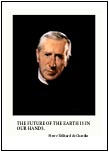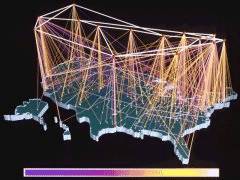
 |
Toward a Theology of the Web: Pierre Teilhard de Chardin and CyberconsciousnessRevised: January 12, 2005 |
These notes began in connection with a discussion I led at the First Parish Church, Unitarian Universalist, Bridgewater, Massachusetts. My interest in the meaning of the web, which began with Teilhard, continues to grow and to lead me to a variety of new ideas. Many thanks to my friend, librarian,and fellow net-head Luke Rosenberger both for the idea and for much of of what appears below.
The following is a cyberbibliography of works related (some more directly than others) to Teilhard's theories on evolution as they relate to the world wide web. You may also find a number of books on the work and life of Teilhard in the Bridgewater State College Library.
If you only have time to read one
article,start
here:
Kreisberg, Jennifer Cobb. "A Globe, Clothing Itself with a Brain."
Wired
6.03
(June 1995): http://www.wired.com/wired/archive/3.06/teilhard.html(Note:This
page recently moved.)
Jennifer Cobb has also published a book, Cybergrace: The
Searchfor
God in the Digital World. (Crown publishers), which is an attempt
to create theology that includes computation in a deep and
meaningful
way. It also includes a chapter on Teilhard. It is available at Amazon.com.
Birx, H. J. "The Phenomenon of Pierre Teilhard de Chardin." Address to Unitarian Universalist Fellowship of Mobile, Alabama, May 4, 1997: http://entropy.me.usouthal.edu/harbinger/articles/rel_sci/birx.html
"Pierre Teilhard de Chardin: Toward a Science Charged with Faith" Cross Currents, the Journal of the Association for Religion and Intellectual Life (ARIL): http://www.crosscurrents.org/chardin.htm
Ellis, D. "Pierre Teilhard de Chardin and the Emergence of Machina sapiens." MiningCo. Guide to Artificial Intelligence: http://ai.miningco.com/library/weekly/aa042797.htm.This article makes the case that evolution must some day move beyond H. sapiens, and that AI is the beginning of that transformation.
Maria Luiza Glycerio's (translated) article on Teilhard's theories ofevolution: http://www.trip.com.br/teilhard/english.htm.
An internet company has been named for Teilhard because its founders were influenced by his ideas. They provide a brief biography.
Teilhard de Chardin Study Group, Academy of Caen, Normandy: http://www.baclesse.fr/~abbat/g-index.html
English translation of passages from Le Phénomène
Humain:
http://www.webcom.com/gaia/tdc.html
For another point of view, Sir Peter Medawar's rather famous critiqueof Le Phénomène Humain: http://www.physics.wisc.edu/~shalizi/Medawar/phenomenon-of-man.html
Other web resources on Teilhard de Chardin:
Oddly enough, the main character in Mike Liegh's 1993 film noir Naked
outlines Tielhard's ideas in a tirade midway through the film.
In January, 2005, The Connection radio
program included Free
Culture Future, which covers innovation in the open source computer
code movement, which some see as a way of bringing the Internet back
toward its original, non-commercial community orientation.
The on-line Beauty Truth and Goodness project is creating a very interesting piece of cooperative cyber-art that embodies Tielhard's vision of the Noosphere.
If you really want to stretch your imagination, consider Tielhard's ideas in relation to the recent developments in DNA-based calculation. For the past 20 years or so, the speed of computers has doubled every 18 months. Most experts agree, however, that this trend will reach a physical barrier in another decade or so. That is, silicon-based calculators will reach their physical limits at around that time. So researchers are considering other materials, and DNA seems a strong possibility, since it already transmits such incredibly vast amounts of data. Visit Yali Friedman's paper, "Everyone'sGuide to DNA Computers," if you want to learn more about this endeavor. The relevance to Tielhard, I think, is that the continued evolution of non-living "intelligent" systems will reach a threshold that might only be surpassed with the use of computational materials from living systems.So the line dividing organic minds from inorganic might become increasingly blurred.
Erica Jean Seidel of Brown University created an interesting
hypertext
entitled "Metaphor:from
Plato to the Postmodernists." By its very nature, this document
requires
exploration, but I will point you to one particular part that is most
relevant
to our discussion: her list of computer
metaphors.
| Ms. Seidel's work pointed me to a fantastic resource at Brown, the cyberspace, hypertext and critical theory page, which points to extensive resources related to the web and literature, the web and politics, the web and economics, the web and well, you get the picture! |
Keeping Cyberspace Free: Tim Berners-Lee and the World Wide Web By E.J. Graff (May/June1999 issue of UU World) Maybe it only stands to reason that something called the World Wide Web was developed by a Unitarian Universalist. But does computer genius Tim Berners-Lee’s invention of the Web make us more or less interdependent?
 |
Cyber-Geography Research exploring the geographies of the Internet, the Web and other emerging Cyberspaces. It is an initiative by Martin Dodge at the Centre for Advanced Spatial Analysis, University College London. It includes an An Atlas of Cyberspaces, which is an atlas of maps and graphic representationsof the geographies of the new electronic territories of the Internet, theWorld-Wide Web and other emerging Cyberspaces, such as the image at left. |
Stanford linguist Geoffrey Nunberg's essay "How the Web Was Won" appeared on NPR's Fresh Air November 9, 1998. In the essay, he explores how the language we use to describe the Internet is changing. He also delves into the meaning of some new spatial metaphors now current on the web, such as "portal" and "hub."
The City of Bits Web site was created in the spring and summer of 1995 as the first full-text interactive book on the World Wide Web. It is a comprehensive introduction to a new type of city, a largely invisible but increasingly important system of virtual spaces interconnected by the emerging information superhighway. William Mitchell makes extensive use of concrete, practical examples and illustrations in a technically well-grounded yet accessible examination of architecture and urbanism in the context of the digital telecommunications revolution, the ongoing miniaturization of electronics,the commodification of bits, and the growing domination of software over-materialized form. Chapter 5, Soft Cities, is particularly rich in its exploration of the geographic implicationsof what I call New Space.
Perhaps one of the most intriguing geographic developments on the web is the emergence of a cottage industry in top-level domain names. The most extreme example is Tuvalu, a Pacific Island nation that would receive little notice on the Internet were it not for the domain name it has been assigned:.tv. A 1998 Reuters article describes the effort to capitalize on this name. The Canadianconcern that is directing the enterprise (and collecting a share of any profits) is internet.tv. So far, sales have been zero, perhaps because of the high fee internet.tv is charging for this modern-day flag of convenience. For a complete list of TLDs (top-level domains), visit NORID.
Chat Roomsand STD's - According to this story from National Public Radio (August 30, 1999 All Things Considered), chat rooms on the internet are the latest target of public health workers fighting sexually transmitted disease. The web has led both to new ways for disease to spread and to new approaches topublic health. This is a seven-minute story requiring RealAudio.
For an excellent critique of where this may be taking society, look
and listen to Jeremy
Rifkin's April 24, 2000 appearance on WBUR's The Connection.
Consider this, from a UUY2K, sitedevoted to the Y2K problem from a Unitarian Universalist perspective, hosted by Rev. Dacia Reid:
The y2k computer failure problem is like a massive intertwined ring of dominoes - one little nudge anywhere in the rings and you stand to witness an amazing chain reaction. In this case the nudgeis the year 2000 and the intertwined rings of dominoes are those aspectsof our society - worldwide - that interact with computers.
James Hayes-Bohanan, Ph.D.
Department of Earth Sciences and Geography
Bridgewater State College
Back to James Hayes-Bohanan's homepage.